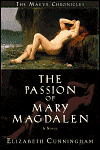 The Passion of Mary Magdalen
The Passion of Mary Magdalen
by Elizabeth Cunningham
Monkfish Publishing
640 pages, $29.95
ISBN: 0976684306
Reviewed by Steven LaVigne
“The road to the country of life is hard. It blisters your feet and breaks your heart” writes Elizabeth Cunningham in her remarkably exciting new age biography, The Passion of Mary Magdalen. Subtitled The Maeve Chronicles, this massive, but refreshing feminist approach to the woman who’s a hero for many who draw strength from the Bible’s most enigmatic character couldn’t have been published at a better time. The worldwide sensation of Dan Brown’s The DaVinci Code has raised so many issues among the Christian population, it was only a matter of time before alternative viewpoints regarding the key people in Christ’s ministry would appear.
Cunningham takes us into the world of Maeve, nicknamed Red, who’s the daughter of the warrior witches of Tir na Mban, including Cailleach, Bride, and Dugall the Brown. Using traditional Biblical concepts that she’s a reformed prostitute, rather than the theory she was born into a wealthy French family, Cunningham’s take on Biblical history and her epic storytelling style are unique. Often The Passion of Mary Magdalen is written in the romantic style of a Harlequin Romance (she even asks readers if the story is “starting to read like a romantic novel,”), yet by combining modern phrases, such as “get a life” or “get over it” with such beautiful metaphors as “the wood is so still you could hear the leaves breathe,” Cunningham gives us a feminist hero for modern times.
Sold into Roman slavery, Maeve’s saga moves quickly from the brothel to servitude to Paulina, the virgin wife of the ancient Claudius. Befriended by Reginus, a gay slave, Maeve’s spiritualism is recognized and after an encounter with her stepfather, Bran, a Druid warrior who, as Rex Nemorensis, guards the holy tree in Diana’s forest, she’s raised to the level of priestess in the Temple of Isis.
The Fascist emperor, Tiberius Caesar forces changes in Rome and the story moves to Judea for its second half, where it really takes off. Using William Blake’s poem “And Did Those Feet” as a basis, Maeve explains that the lost (Gnostic) gospels are mostly speculation, when Esus (the Celtic name for Jesus) aka Yeshua, enters the story in Chapter 37. Franco Zefferelli modernized the Virgin Birth by having Mary go through labor pains in Jesus of Nazareth and Cunningham further modernizes the Mother by drawing an unflattering portrait of Miriam/Mary.
Cunningham creates a complex woman, conflicted in her love for Jesus and her need to serve Isis. She has a sexual relationship with Jesus, thus humanizing the man, and she connects the tale of the Good Samaritan to Jesus’ 40-day fast in the desert, having the Samaritan deliver him to the Temple Magdalen, built to worship all goddesses and gods, because “all things are possible.” Baptized by John in the river Jordan, Maeve dislikes Simon Peter, calling him “Rocks for Brains,” and Cunningham focuses on Maeve’s passions, especially in the saga’s compelling second half.
The Passion of Mary Magdalen has been rightly compared to Marion Zimmer Bradley’s The Mists of Avalon. Just as that book told the legend of King Arthur from the women’s viewpoint, The Passion of Mary Magdalen by Elizabeth Cunningham brings its title character into modern times by creating an extraordinary perspective of the woman loved by Jesus. For the novice, the Biblical scholar and the Feminist, this is a book that’s not to be missed.
Steven LaVigne lives in Minneapolis, Minnesota and is a contributing writer to White Crane.